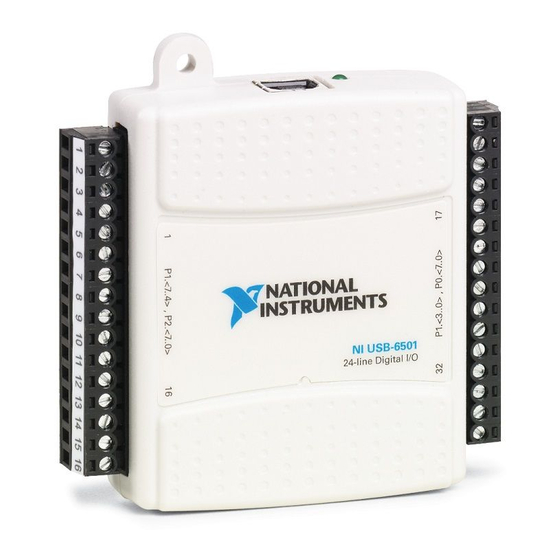Table of Contents
Advertisement
USER GUIDE
NI USB-6501
24-Channel, 32-Bit Counter Digital I/O Device
The National Instruments USB-6501 is a Full Speed USB 2.0 device that provides 24 DIO
channels and a 32-bit counter. This user guide describes how to use the device.
For specifications, refer to the NI USB-6501 Device Specifications document available at
ni.com/manuals.
The following figure shows key functional components of the NI USB-6501.
1
2
1. USB Cable Strain Relief
2. Screw Terminal Connector Plug
The following figure shows key functional components of the NI USB-6501.
Figure 1. NI USB-6501 Top and Back Views
NI USB-6501
24-line Digital I/O
2
3
4
3. LED Indicator
4. USB Connector
Advertisement
Table of Contents

Summary of Contents for National Instruments USB-6501
- Page 1 NI USB-6501 24-Channel, 32-Bit Counter Digital I/O Device The National Instruments USB-6501 is a Full Speed USB 2.0 device that provides 24 DIO channels and a 32-bit counter. This user guide describes how to use the device. For specifications, refer to the NI USB-6501 Device Specifications document available at ni.com/manuals.
-
Page 2: Safety Guidelines
NI USB-6501. Caution Operate the NI USB-6501 only as described in these operating instructions. Misuse of the device can result in a hazard. You can compromise the safety protection built into the device if the device is damaged in any way. If the device is damaged, contact National Instruments for repair. - Page 3 Working voltage is the highest rms value of an AC or DC voltage that can occur across any particular insulation. MAINS is defined as a hazardous live electrical supply system that powers equipment. Suitably rated measuring circuits may be connected to the MAINS for measuring purposes. NI USB-6501 User Guide | © National Instruments | 3...
-
Page 4: Installing The Software
Install the NI-DAQmx driver or the NI-DAQmx Base driver. Connecting the Device Before installing the NI USB-6501, you must install the software you plan to use with it. Complete the following steps to set up the NI USB-6501 device: Install the combicon screw terminal blocks by inserting them into the combicon jacks. -
Page 5: Usb Cable Strain Relief
Connect the wiring to the appropriate screw terminals. Use the provided USB cable to connect the NI USB-6501 device to your computer. Features The NI USB-6501 features USB cable strain relief, an LED indicator, and two screw terminal connector plugs for I/O. USB Cable Strain Relief... -
Page 6: Led Indicator
Figure 4. USB Cable Strain Relief LED Indicator The green LED next to the USB connector on the NI USB-6501 device indicates device status, as listed in the following table. When the device is connected to a USB port, the LED blinks steadily to indicate that the device is initialized and is receiving power from the connection. - Page 7 Digital I/O Signal: As a digital line, this signal can be used as an input or output. CTR: As a counter, this signal can be used as an event counter input source. NI USB-6501 User Guide | © National Instruments | 7...
-
Page 8: Static Dio
Ground: The reference for the digital signals and the +5 VDC supply. Digital I/O The NI USB-6501 device has 24 single-ended digital lines that comprise the three DIO ports: P0.<0..7>, P1.<0..7>, and P2.<0..7>. P2.7/PFI 0 can also function as a 32-bit event counter. Static DIO Each DIO line can be individually programmed as a static DI or DO line. -
Page 9: Determining The Pull-Up Resistor Value
The following figure shows some common examples of connections of DIO lines with standard circuits. In the figure, P0.<0..7> is connected to example signals configured as digital inputs and digital outputs. You can configure P1.<0..7> and P2.<0..7> similarly. NI USB-6501 User Guide | © National Instruments | 9... - Page 10 Caution Exceeding the maximum input voltage ratings or maximum output ratings listed in the device specifications can damage the DAQ device and the computer. National Instruments is not liable for any damage resulting from such signal connections. I/O Protection Each DIO signal is protected against overvoltage, undervoltage, and overcurrent conditions, as well as ESD events.
-
Page 11: P2.7/Pfi 0 Event Counter
+5 V Power Source The NI USB-6501 supplies a nominal 5 V from two pins, one on each screw terminal block. The voltage source is provided by the USB host. The voltage is nominally 5 V but varies from system to system. -
Page 12: Related Documentation
NI-DAQmx The NI USB-6501 Quick Start included with the NI USB-6501 describes how to install NI-DAQmx software, install the device, and confirm that your device is operating properly. The NI-DAQmx Readme is available from the Windows Start menu and lists which application software, devices, and ADEs are supported by this version of NI-DAQ. - Page 13 Measurement Studio Application Wizard and the DAQ Assistant, refer to Walkthrough: Creating a Measurement Studio NI-DAQmx Application. • For help with NI-DAQmx methods and properties, refer to NationalInstruments.DAQmx Namespace and NationalInstruments.DAQmx.ComponentModel Namespace. NI USB-6501 User Guide | © National Instruments | 13...
-
Page 14: Training Courses
Worldwide Support and Services The National Instruments website is your complete resource for technical support. At ni.com/ support, you have access to everything from troubleshooting and application development self-help resources to email and phone assistance from NI Application Engineers. - Page 15 National Instruments corporate headquarters is located at 11500 North Mopac Expressway, Austin, Texas, 78759-3504. National Instruments also has offices located around the world. For telephone support in the United States, create your service request at ni.com/support...
- Page 16 Other product and company names mentioned herein are trademarks or trade names of their respective companies. For patents covering National Instruments products/technology, refer to the appropriate location: Help»Patents in your software, the file on your media, or the National Instruments Patent Notice at .













Need help?
Do you have a question about the USB-6501 and is the answer not in the manual?
Questions and answers